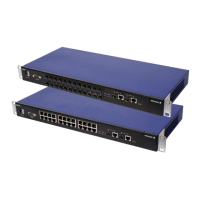Glossary
However, it is possible to prohibit broadcast on a specific egress connection.
Multicast packets, which are distributed as broadcast, will not be let through on
egress connections where broadcast_allowed is set to false.
If no uplink is defined, multicast packets will always be broadcast when Yes is
selected.
CLI Commands
Most multicast-related settings are set using the set vlan command, since
all multicast handling is done per switching domain. The following arguments
are relevant to multicasting:
multicast {igmp_proxy|igmp_snooping|no|yes}
proxy_ip_address <IP-address>
igmp_immediate_leave {no|yes}
igmp_query_interval <interval>
igmp_query_response_interval <interval>
For detailed information on these commands, please refer to section 13.8.23
on page 141.
A related command is add connection vlan <vlan> ethernet_port
<port> valid_multicast_groups <IP_address>, which is used to set
the multicast addresses that the user is allowed to subscribe to. For detailed
information on these commands, please refer to section 13.8.1 on page 107.
Displaying Subscribed Multicast Groups
Using the get command with the resource vlan will display all multicast
groups subscribed to for the switching domain. To view a single port, use get
with the connection.
5.3.4 Switching Domain – Broadcast
By definition, broadcast packets are intended to reach all other stations on the
network. Here, ‘the network’ is restricted to the virtual network defined by the
switching domain.
Accordingly, by default, every broadcast packet arriving at a switching domain
is sent out on every egress connection, except the one to the port on which
the packet arrived. Depending on the configured switching rule and forced
forwarding mechanisms, forwarding of broadcast packets may be restricted
even further.

